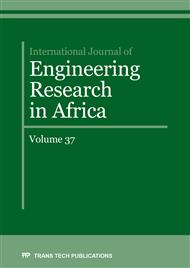[1]
H., Yemendzhiev, Z., Alexieva, and A., Krastanov, Decolorization of synthetic dye reactive blue 4 by mycelial culture of white-rot fungi trametes versicolor 1, Biotechnology &. Biotechnological Equipment. 23(3) (2009) 1337–1339.
DOI: 10.1080/13102818.2009.10817665
Google Scholar
[2]
A., Elhalil, H., Tounsadi, R., Elmoubarki, F. Z., Mahjoubi, M., Farnane, M., Sadiq, M., Abdennouri, S., Qourzal, and N., Barka, Factorial experimental design for the optimization of catalytic degradation of malachite green dye in aqueous solution by Fenton process. Water Resources & Industry. 15(2016).
DOI: 10.1016/j.wri.2016.07.002
Google Scholar
[3]
A., Adeyi, I. A., Mohammed, A. S., Yusuff, I. I., Olateju and L. T., Popoola, Textile waste water treatment and colour removal using chemically activated sawdust. Journal of Bioprocessing & Chemical Engineering. 1(3) (2014) 1-6.
Google Scholar
[4]
N., Akhtar, H., Tahir, M., Sultan, G., Yasmeen, and U., Hameed, Application of chitosan padded rice and wheat husk for the removal of reactive dye from aqueous solution, African Journal of Biotechnology. 11(64) (2012) 12756-12765.
Google Scholar
[5]
M., Shashikala, M., Nagapadma, L., Pinto, and S. N., Nambiar, Studies on the Removal of Methylene Blue Dye from Water Using Chitosan. International Journal of Development Research. 3(8) (2013) 40-44.
Google Scholar
[6]
P. N. Bhavani, A. V. R. Krisha Rao. G. Anshu, K., Ashok, K. D., Raj, Synthesis, characterization and enhanced photocatalytic degradation efficiency of Se doped ZnO nanoparticles using Trypan Blue as a model dye. Applied Catalysis A-Gen. 459 (2013).
DOI: 10.1016/j.apcata.2013.04.001
Google Scholar
[7]
S. R., Vijayalakshmidevi, M., Karuppan, Improved biodegradation of textile effluent by coculture. Environmental Safety. 114 (2015) 23-30.
DOI: 10.1016/j.ecoenv.2014.09.039
Google Scholar
[8]
J. L., Chihim, Y., Joanne, and M. Y., Chunwah, A Comprehensive Study on Adsorption Behaviour of Direct, Reactive and Acid Dyes on Crosslinked and Non-crosslinked Chitosan Beads, Journal of Fiber Bioengineering & Informatics. 7(1) (2014) 35-52.
DOI: 10.3993/jfbi03201404
Google Scholar
[9]
F. M., Rumengan, E., Suryanto, R., Modaso, S., Wullur, T. E., Tallei, and D., Limbong, Structural Characteristics of Chitin and Chitosan Isolated from the Biomass of Cultivated Rotifer, Brachionus rotundiformis. International Journal of Fisheries and Aquatic Sciences. 3(1) (2014).
DOI: 10.35800/jasm.0.0.2013.2286
Google Scholar
[10]
M. M., Islam, S. M. Shah Md. Masumb, M. M., Rahmana, M. A. I., Mollab, A. A., Shaikhc, and S. K., Roy, Preparation of Chitosan from Shimp Shell and Investigation of Its Properties, International Journal of Basic & Applied Sciences. 11(1) (2011).
Google Scholar
[11]
Q., Yimin, S., Bingbing, and L., Jingjie, Application of Chitosan and Alginate in Treatment of Water Containing Heavy Metal Ion, Indian Journal of Chemical Technology. 13 (2006) 464-469.
Google Scholar
[12]
A., Alihosseini, V., Taghikhani, A. A., Safekordi, and D., Bastani, Equilibrium sorption of crude oil by expanded perlite using different adsorption isotherms at 298.15 K, International Journal of Environmental Science & Technology. 7 (3) (2010).
DOI: 10.1007/bf03326168
Google Scholar
[13]
H. R., Tashauoei, H., Movahedian Attar, M., Kamali , M. M., Amin, and M., Nikaeen, Removal of Hexavalent Chromium (VI) from Aqueous Solutions using Surface Modified Nanozeolite A, International Journal of Environmental Resources. 4 (3) (2010).
DOI: 10.1007/bf03326159
Google Scholar
[14]
R., Farouq, and N. S., Yousef, Equilibrium and Kinetics Studies of adsorption of Copper (II) Ions on Natural Biosorbent. International Journal of Chemical Engineering & Applications. 6(5) (2015) 319-324.
DOI: 10.7763/ijcea.2015.v6.503
Google Scholar
[15]
M., Nounou, and H. Nounou, Multiscale estimation of the Freundlich adsorption isotherms, International Journal of Environmental Science & Technology. 7(3) (2010) 509-518.
DOI: 10.1007/bf03326160
Google Scholar
[16]
I., Ozbay, I., Ozdemir, B., Ozbay, and S., Veli, Kinetics, thermodynamics, and equilibrium studies for adsorption of azo reactive dye onto novel waste adsorbent: charcoal ash. Desalination & water treatment. 51(2013) 6091-6100.
DOI: 10.1080/19443994.2013.763387
Google Scholar
[17]
A., Adeyi, A., Giwa and V. A., Adeyi, Kinetic analysis of manganese dioxide adsorbent on desulphurization of diesel oil. International Journal of Scientific & Engineering Research. 6(7) (2015) 650-658.
Google Scholar
[18]
Y. B., Onundi, A. A., Manun, M. F., Al Khatib and Y. M., Ahmad, Adsorption of copper, nickel and lead ions from synthetic semiconductor industrial wastewater by palm shell activated carbon. International Journal of Environmental Science & Technology. 7(4) (2010).
DOI: 10.1007/bf03326184
Google Scholar
[19]
I., Okoye, P. M., Ejikeme and O. D., Onukwuli, Lead removal from wastewater using pumpkin seed shell activated carbon: Adsorption modelling and kinetics. International Journal of Environmental Science & Technology. 7(4) (2010) 793-800.
DOI: 10.1007/bf03326188
Google Scholar


